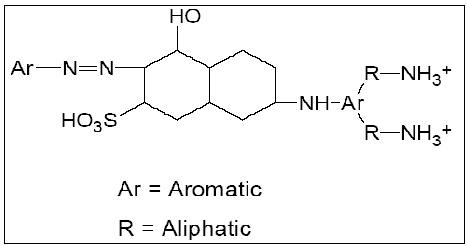Over the years Paper makers have used dyes. Seeing
the growth in the paper industry it can be safely assumed that Dyes for
paper industry has a very promising future. Given below is a
comprehensive list of the various grades of paper that are open to
dyeing.
- Writing and printing paper
- Tissue - Facial, toilet, towel, napkin
- Copier papers
- Boards/Cover papers
- Decorative laminated paper
- Packaging grades - corrugated case stuff
- Envelope grades
- Specialty papers like, label, laundry tag, posters
The dyes that are used includes sulphur dyes and cationic direct
dyes. Other than these two popular options acid dyes and basic dyes are
also used. Sulphur dyes are reduced alkaline solutions. For example to
get the colour black, a polymer is obtained by the result of a reaction
between. 2, 4 dinitrophenol and sodium polysulphide. The polymer
structure is shown below.

Coming to the Cationic Direct Dye, some features which makes them
suitable towards use in paper are:
- An extended conjugation
- A planar molecular structure
- An excess of positive charge over the negatively charged surface
groups
A typical structure of a cationic direct dye is given here.

To give a stable paper, the dye selected must give:
- Right shade
- Optimum depth
- Clear backwaters
- Good affinity
- Show light fastness
- Show bleed fastness
- Provides stability to temperature and humidity
- Low or no metamerism
- Compliant with regulations in force
- Safety in Handling
- Does not affect any other paper chemical/process or parameters


